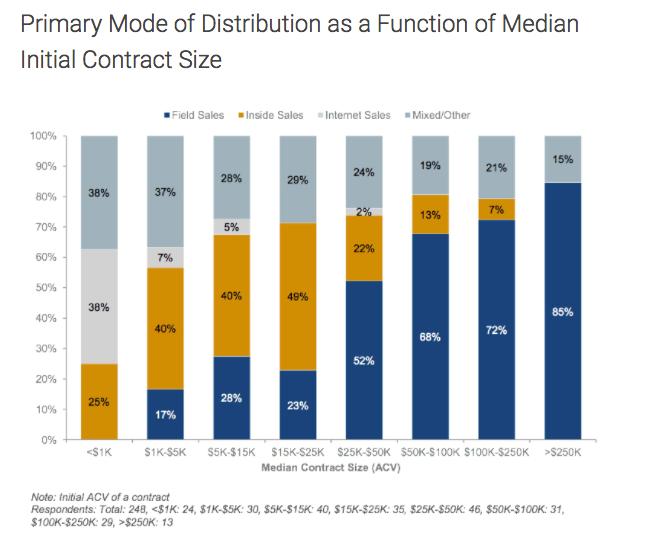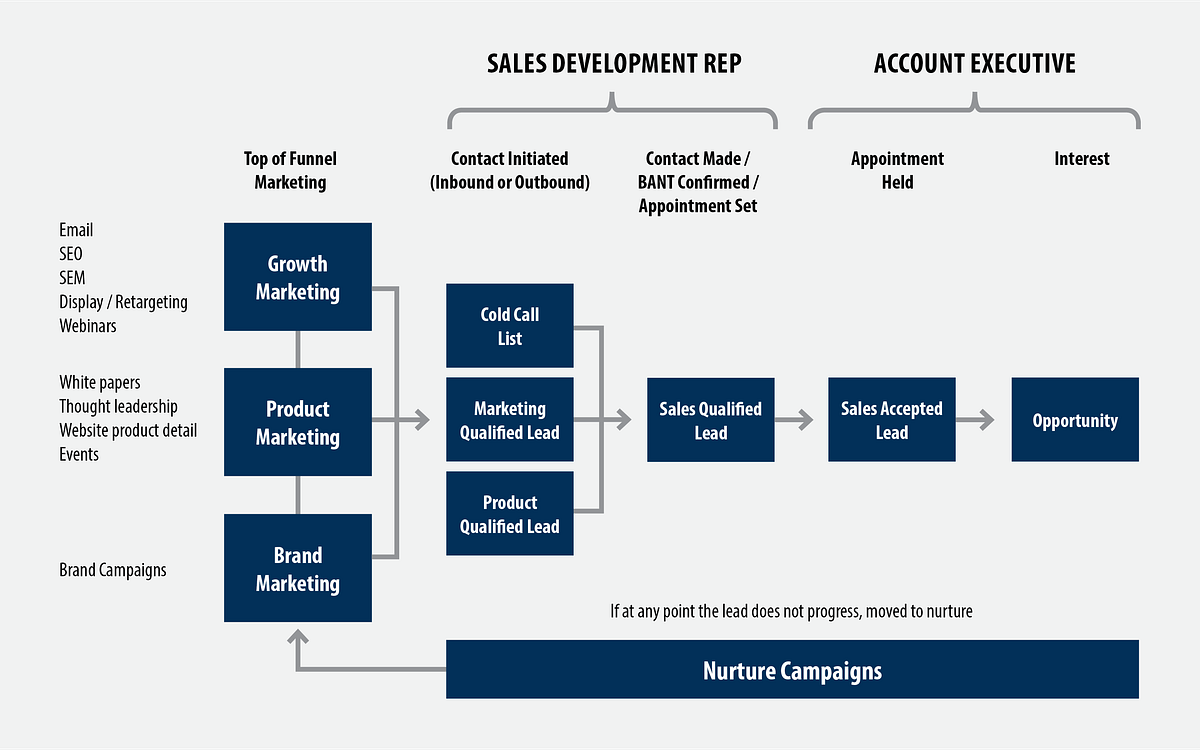At Mid Funnel, conversion is king.
This chapter concerns the Mid Funnel domain of the Bow Tie:

As always, Mid Funnel design varies by business model:
- Very Low LTV: Millions of consumer prospects; fully automated Mid and Bottom Funnel (“first mile” of the product experience)
- Low LTV: Hundreds of thousands of consumer or business prospects; lead-based demand generation, possibly with a call center for Bottom Funnel conversion
- Mid LTV: Thousands of prospects; high velocity, mass-customized, account-based marketing
- High LTV: Hundreds to thousands of prospects; moderately customized account-based marketing (ABM)
- Very High LTV: Hundreds of prospects; highly customized ABM
Business model variations can be seen in the research data. Note how the percent of CAC dedicated to marketing vs. sales varies based on the type of sale — from field sales to inside sales to internet sales:

Source: David Skok,“2016 Pacific Crest SaaS Survey”¹
Here, we focus on businesses with Mid LTV business models and higher.
Prospect engagement strategy has evolved. Just a few years ago, the role of marketing in a tech company was to drive leads. Marketing generated the leads and sales sold them. No thought was given to business model variations.
For Very Low and Low LTV business models, this lead generation approach makes sense. Leads come from individuals. Since at the low end of the LTV spectrum decisions tend to be made by one individual (either a consumer or an SMB owner), leads are what’s needed.
But for higher LTV business models, a leads-based marketing approach that’s not closely connected to the prospect account is ineffective. In the enterprise, multiple individuals make buying decisions. There’s the decision maker, the influencers, the users, and (sometimes) the blockers. Leads don’t buy products — accounts do. For these business models, a new approach has gained traction: account-based. Jon Miller, CEO of the account-based marketing platform company Engagio, describes the account-based approach as follows:
“Account-based marketing is a strategic approach that coordinates personalized marketing and sales efforts to open doors and deepen engagement at specific accounts.”²
At Top of Funnel, you reached and engaged prospects and customers. Your mission was to achieve vision lock (“I get what you do and why it’s relevant to me”). Now it’s time for the journey towards conviction lock (“I’m convinced. Sign me up”).
For Mid LTV and higher business models, the Mid Funnel mission is to design and effectively execute a high-engagement orchestration plan. This plan must swarm the right people inside the right accounts in the right segments with multi-touch connections and spot-on messaging that builds conviction. On the journey to conviction lock, the orchestration plan’s objective is to increase speed to the “aha” moment and speed to trust.
Proof of success is shown by:
- High conversion
- Increased bookings
- Sales cycle compression
- Cost efficiency
The Fundamentals
Step One: Build a Sales Ready Product
To deliver speed to “aha,” get the product in front of the prospect as quickly as possible. The light bulb moment only happens once a prospect has seen the product and started using it. To achieve this, you need to build a product utility that provides a glimpse into the full product experience, is available via an online link, and can be sent to prospects. A prospect that has already experienced part of the product experience is significantly more likely to advance along the funnel. This idea was explored more fully in Chapter 18 — Top of Funnel.
Step Two: Build the Tools and Workflow
A core principle of cost-efficient Mid Funnel execution is this: everything that can be automated should be automated. The ratio of automated to human activity shifts steadily to favor human intervention as LTV increases. However, even for Very High LTV businesses, automation is important. For instance, your orchestration plan is sure to include a catalog of nurture campaigns — created by product marketers and growth marketers — that executes automatically based on various contact or account states. In the Mid Funnel workflow, the sales development rep (SDR) role comprises the human activity which is sparked by automated triggers from sales automation tools. Product marketers, growth marketers, and SDRs need the right tools and platforms to power the workflow.

The SDR function is vital. Under the canopy of digital — and sometimes analog — campaigns, SDRs execute both cold and warm MQL follow-up calls and custom emails to contacts that fit the ideal customer profile (ICP) target personas. These live connections are central to building prospect engagement. SDRs are on the frontline ascertaining whether prospects exhibit the right budget, authority, need, and timing (BANT) to qualify as a sales qualified lead (SQL) so that the account executive (AE) demo call can be scheduled.
Leads come from people, but accounts buy. So leads must be associated with accounts, following the principle of “right person, right company.” You seek to touch multiple people within a target account. Of course, the result is multiple leads from multiple people from a single account.
Sales engineers play an important role in providing technical validation throughout Mid Funnel the sales process.
Step Three: Build out your Orchestration Plan and Messaging
Your orchestration plan defines how you will engage your ICP personas and in what sequence.

Source: Scott Albro, CEO of TOPO³
This includes all Mid Funnel digital marketing such as email nurture campaigns and thought leadership content campaigns. The plan includes trade shows, lunch-and-learns, and account-specific events. You build digital campaigns that are triggered when contacts and accounts achieve certain states. These campaigns deliver the prospect state-specific and persona-specific nurture content. Human touch points are triggered by defined contact and account states, and executed as appropriate by SDRs, AEs, Field Sales Engineers, managers, VPs, and even the CEO. All of these are part of your orchestration plan.
Your product marketing and growth marketing playbooks are the guides for all automated messaging and your sales development playbook defines your SDR scripts and plays (see Chapter 16 — Messaging Schema). Automated messaging is necessary, but not sufficient. It’s the custom content that is the key to ABM effectiveness. The degree of effort put into content customization rises steadily from Mid LTV to High LTV to Very High LTV business models.
For Mid LTV, where lifetime value is between $10,000 and $100,000, CAC can range from $3,000 — $30,000. Here, short blocks of custom content sit inside email templates or white paper templates comprised primarily of standardized content. Custom content is gathered from public data in a highly efficient (probably off-shore) workflow, quickly converted by high-speed writers into prose, and uploaded to the platform for auto-merge.
For High and Very High LTV business models, there is a greater degree of content customization. For instance, in the Very High LTV business model, business analysts might execute a comprehensive ROI analysis or competitive alternatives analysis for a single prospect. Or develop a completely customized market trends or maturity assessment white paper. Or all four. If the LTV is greater than $500,000, more than $150,000 is available to spend to reel in a single customer. As you can see, the customization effort needed in these higher LTV business models is significant.
Step Four: Find your Prospects
Everything hinges on finding the right people. Your ideal customer profile (ICP) emerges from top priority segments in your segmentation scheme (see Chapter 4 — Customer Segmentation). You define your ICP attributes with specificity in order to pinpoint the prospect accounts you seek to target. You build your prospect database with both account and contact details. You align messaging to your buyer, influencer, and user personas.
For the Mid LTV business model, you generically define the roles and titles of your buyers, influencers, and users. Here, data gathering focuses on account discovery and contact data capture. Lists may be purchased to expand your prospect database. Predictive scoring tools may be used to support optimization of the ICP definition and to find “accounts like this.” You may deploy a team (for cost purposes, often located offshore) that augments your account data in preparation for active engagement.
In Very High LTV business models, however, the universe of accounts is, at most, in the hundreds. So, data gathering is highly customized. You need to know the exact names, titles, and contact details of the buyers, influencers, users, and blockers inside each company. For each prospect account, a “mole” is required to provide insight into purchase decision steps, decision participants, key company priorities, and other decision-influencing factors.
Step Five: Train your People
SDR enablement is fundamental if you are to achieve your key objectives of high conversion, a compressed sales cycle, maximization of customer spend, and cost efficiency. It’s not uncommon for an SDR to be expected to execute 40 or more phone calls and 40 or more emails per day. Doing it well requires training.
Since most phone calls go to voicemail or result in an immediate hang-up, live connections must be executed effectively. Once the prospect says “hello,” an SDR has five seconds to win 30 seconds, 30 seconds to win 2 minutes, and 2 minutes to win a demo. Therefore, train SDRs effectively to deliver carefully developed scripts. Ensure that SDRs can execute these phone-based “moments of truth” to positive effect.
Measure your SDRs on number of calls made, number of emails sent, conversion of calls to scheduled demos, conversion of scheduled demos to demos held, and conversion of demos held to sales accepted lead (SAL). It is critical to establish performance thresholds for the second week and the first month with consistent above-threshold performance expected by the third month.
The SDR’s primary enablement tool is the sales development playbook (see Chapter 16 — Messaging Schema).
Managing Channel Partnerships at the Mid Funnel Stage
If your business depends on the effective execution of channel partnerships, then you will face a different challenge. Success depends, of course, on best-practice Mid Funnel prospect engagement via a well orchestrated ABM strategy. But the strategy and its execution are beyond your control. What can you do?
Start with a vision of best practice. If you don’t understand ABM best practice, you can’t influence your channel partner to adopt it. Once you have vision clarity, you need to accurately pinpoint the current state of your partner’s Mid Funnel engagement effort. Visibility is vital. To achieve visibility, best practice is for you to place a partner manager inside your partner’s offices. Co-location is by far the best way to ensure you know what’s really going on.
Transparency and trust are the foundational requirements for collaboration.
Once you know “the good, the bad, and the ugly” in your partner’s Mid Funnel engagement execution, your job becomes one of communication and influence.
It’s possible that some of the levers of Mid Funnel prospect engagement are controlled by you. You might manage the thought leadership and product marketing content that provides the canopy under which your partner engages. If so, then orchestration, communication, and coordination all become even more critical and challenging to a successful partnership.
In the end, it comes down to your partner’s competency and willingness to collaborate. If you have a strong partnership, both companies will be highly motivated to continuously improve.
Summary
At the Mid Funnel stage, executional discipline is the order of the day. Multiple people in your company must execute multiple touch points with multiple people in your target accounts. Everything needs to follow the orchestration plan in volume and at scale. To get there takes time and difficult, granular optimization work.
Keep at it. Rigor wins.
. . .
Notes:
- David Skok. “2016 Pacific Crest SaaS Survey — Part 1.” Blog post. forEntrepreneurs.com. 2016.
- Jon Miller, CEO of Engagio. The Clear and Complete Guide to Account Based Marketing. Booklet on website. engagio.com. 2017.
- Scott Albro, CEO of TOPO. “Account-Based Everything.” San Francisco, CA. September 2016. Private presentation to CEO Quest members.
. . .
If you would like more CEO insights into scaling your revenue engine and building a high-growth tech company, please visit us at CEOQuest.com, and follow us on LinkedIn, Twitter, Facebook, and YouTube.

